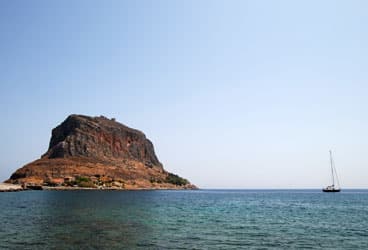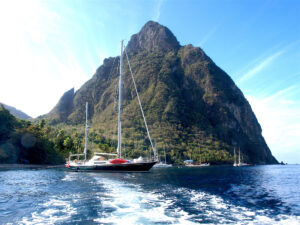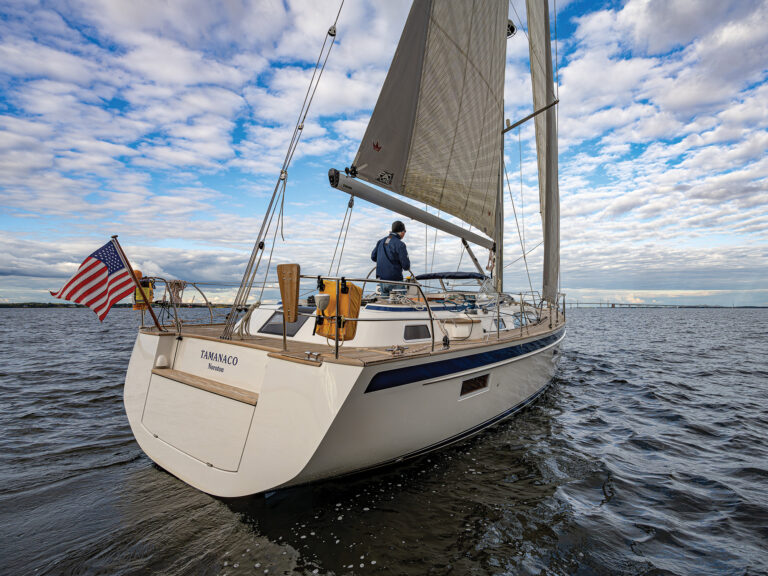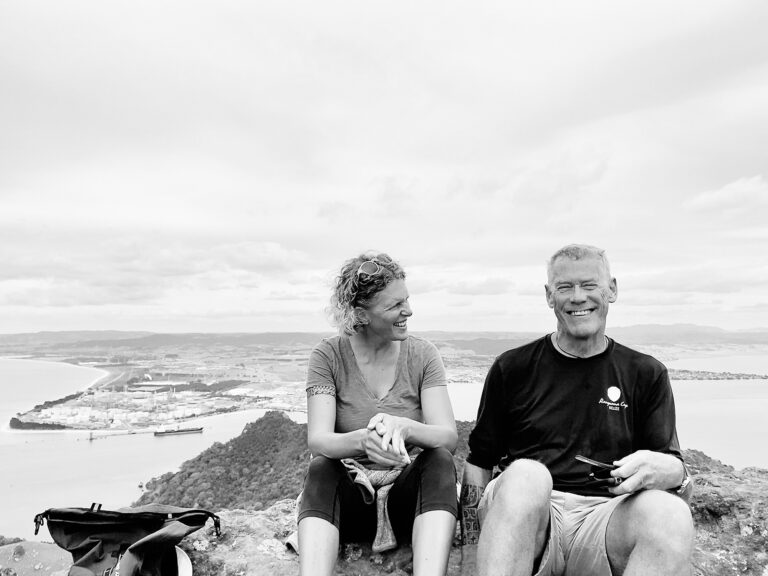
monemvassia
The meltemi came out of the north, singing in the halyards and standing rigging all night and all the next day. Occasionally, the wind would gust spectacularly, causing the boat to dance on its anchor line and the song to become a shriek. There were only four other sailboats in the cove, and we’d watched two of them drag their anchors the previous night. Nobody had ventured in or out all day. Our anchorage was a shallow cove off the tiny Greek island of Elafoníssi, which lies north of Kíthira and to the west of Cape Maléas. Flat and barren, Elafoníssi didn’t offer much protection from the wind. We were waiting for the breeze to lie down so we could round Cape Maléas and sail north along the coast of the peninsula to the medieval fortress city of Monemvassía.
That afternoon, I dove down the anchor line. We had so much chain out that the anchor was lying peacefully on its side without so much as a mark left in the hard sand. This worried my cousin Vasilis—who has many years of sailing experience in these waters—so he initiated the reanchor drill. With Vasilis at the bow flashing hand signals to my son, Nick, at the tiller, we motored closer to shore and found better holding ground. My job was to watch the depth finder, which was somewhat redundant, since we could all see the bottom. Vasilis’ pride and joy is Thetis, his 38-foot sloop named after the mother of Achilles. Nick and Vasilis had sailed Thetis from Tunisia, and they were a well-oiled team when I’d joined them in Pilos, on the southwestern coast of the Peloponnesus.
The southern part of the peninsula extends three long fingers of land south into the Mediterranean Sea; the three fingers are separated by two bodies of water, Messiniakós Gulf and Lakonikós Gulf. Each finger of land has its own history and character. We sailed south past the town of Methóni, praised by Homer for its wine and natural beauty. Tradition says that the grapes there are so potent that the donkeys can get drunk carrying them to market. This finger of land ends at Cape Akrítas, and we rounded it and entered Messiniakós Gulf, which we sailed across to the next finger, Mani. With its dark, craggy ridges and steep gorges leading down to the sea, Mani is a mysterious and foreboding place. It’s said to be the only region of Greece that’s never been conquered. The people who lived here were famous for their blood feuds and banditry. Descended from the Spartans, they were so fierce that they were constantly at war with neighboring families. They built homes called tower houses, which are rectangular stone structures of several stories that were erected for defense, not for comfort: They have no windows on the ground floors. Cruising along the coast of Mani, you can still see these fortress homes high up in the hills, continuing to stand vigilant. We rounded Cape Ténaro, on the tip of Mani, and entered Lakonikós Gulf, where we waited before sailing around the tip of the third finger, Cape Maléas.
Of the three capes, Maléas has always been considered the most difficult to navigate. Renowned for its shifting winds and nearby currents, it’s been called the Cape Horn of Greece. It was infamous even back in the days of Odysseus. In fact, according to Homer, it was Odysseus’ failure to successfully navigate Maléas from the east that led to his long odyssey. And so we waited prudently while the north wind continued to blow.
Although Elafoníssi is way off the beaten path for tourists, Greeks come over from the neighboring island of Kíthira or from the town of Neápoli, on the mainland. Two beaches lie on the north side of the island; behind them stand hundreds of high sand dunes. Since Vasilis was reluctant to leave the boat and Nick had gone off spearfishing in the shallows, I decided to swim ashore and explore. I didn’t use the Zodiac because the outboard wasn’t working; I’d had visions of trying to make it to shore with the flimsy plastic paddle but getting blown backward to Africa, like Odysseus. But after swimming only 20 yards from the boat, I found I was standing on hard white sand and could wade ashore.
It was a short walk to the windward side of the island. As I got close to the other shore, the scrub brush and stunted pines gave way to the dunes. I’d never seen this before in Greece. The beach was two large crescents of pure white sand divided by a rocky headland. The whitecapped blue sea turned pale in the shallows and kicked up steep, green waves that curled and rolled to shore. I felt as if I were back on Cape Cod, in Massachusetts. Alas, no one was nearby to appreciate my bodysurfing exhibition.
When I was back on board, Vasilis studied the weatherfax. The forecast called for the wind to decrease by nightfall, so he decided we should leave that evening for a night sail around Maléas, with the intention of arriving at dawn at Monemvassía. He suggested that we all take a nap, then be ready to go. I tried to sleep, but the groaning of the anchor chain and that vision of poor Odysseus drifting south kept me awake, so I got out my guidebooks and read up on Monemvassía.
If Maléas is the Cape Horn of Greece, Monemvassía is its Gibraltar. The massive mountain of stone cracked away from the mainland during an earthquake in 375. Because it rises precipitously to a height of nearly 1,000 feet, it became a natural refuge and strategic stronghold from which to control the sea lanes between the Mediterranean and Aegean. Of course, given these attributes, Monemvassía has had, as a consequence, a long and embattled history. In the 6th century, when Greece was part of the Byzantine Empire, a walled city was built on the steeply sloped hillside facing the sea. This fortress of a town became wealthy under Byzantine rule. In 1249, it was captured by the Crusaders. It was returned to the Byzantine Empire in 1263, fell to the Turks in 1540, to the Venetians in 1690, and back to the Turks in 1715. In 1821, during the Greek War of Independence, Monemvassía was liberated after a four-month siege and finally returned to Greece. Now Monemvassía is enjoying a new invasion by wealthy Greeks and other Europeans who have turned the old stone houses into a very exclusive resort community. Still, they must sense that they share the rock with the ghosts of many centuries.
At sunset, we weighed anchor and headed toward Maléas. The wind was steady at about 20 knots from the north, and we made good time on a broad reach flying just the big genoa. Since Nick’s spearfishing had been unsuccessful, it was another night of Vasilis’ ubiquitous specialty, pasta puttanesca. As night fell, Maléas became a dark shadow off our port bow. Overhead, the stars came out, and the Milky Way appeared like a silver cloud spread above us. As we approached Maléas, the wind became fickle, which caused the big genoa to complain noisily, so we eventually had to roll it in and turn on the engine.
Maléas was ultimately benign. The sea was calm, and the only real danger we faced came from shipping. It looked like a nautical turnpike, as tankers and freighters followed each other in single file around the cape and headed up into the Aegean or out into the Mediterranean. We could see only the red portlights and white stern lights of ships passing west, or the green lights and white lights of those headed east. Vasilis monitored the radar while Nick and I watched for any ship showing both green and red, which would mean that it was headed straight for us. We took evasive action once to avoid a freighter by a few hundred yards. As it passed, we circled in behind it. Except for its running lights, it seemed deserted, massive, and utterly aloof. When we finally rounded the cape and hugged the coast, the ships headed away from us. We picked up a land breeze that allowed us to set the genoa. The steady, warm offshore breeze smelled sweet, and we sailed along smoothly in a flat sea.
It was still a few hours before dawn, and Nick and Vasilis were tired. They both had plenty of night sailing in the bank, but I had no desire to miss any of this. The sea was empty, and the autopilot was set. Only Monemvassía lay before us. They turned the watch over to me, and I agreed to wake them at dawn. The lights went out below, and I was alone with the thyme-scented breeze and the whispers of the sea. I had that feeling that comes along once in a great while—if you’re really blessed: There was no place else on Earth I would’ve rather been.
The mountainous coast was dark, silent, and empty. But occasionally, high up on the hillside, there would be a flickering of light. Perhaps it was a small chapel. The Greeks build little white churches in the most remote and inaccessible places possible. You’ll often see them at the top of mountains. They haunt the landscape. Then, after I’d seen nothing for several miles, there appeared a string of lights in the shape of the cross. It must have spanned hundreds of yards. I was reminded of the words of Lord Byron: “Where’er we tread ’tis haunted, holy ground.”
Low in the eastern sky, Venus faded in the early light of dawn. I woke up the crew. Over a breakfast of crusty bread, feta cheese, and strong coffee, we watched Monemvassía emerge. At first, it appeared to be a barren mountain towering above the shore, but as we came closer, we could see thick walls running across its base and extending upward. Gradually, we began to see the shapes of roofs and domes within the walls, and these took on shades of color. If we’d been the vanguard of the Venetian fleet approaching by sea, the impression would have been one of impregnability. When we were within a few hundred yards, we could see that the rock was connected to the mainland by a small bridge. The little city was built on a steep incline and climbed upward between narrowing walls. At the top of the rock, beyond the ramparts, it appeared that all was in ruins except for a single church sitting alone at the very edge of the precipice.
We doused sail and motored into Gefyra, a town on the mainland with a ferry dock and 20 slips for visitors. We had to muscle our way into the only slip available between a finger pier and a broad-beamed sailboat flying the French flag. As I jammed a fender between the two boats, a puffy-faced skipper poked his head out and mumbled a less than friendly greeting. I shrugged my shoulders, smiled apologetically, and pointed to Vasilis. It was a tight squeeze, but there was no damage done, and our new friend went back to bed. The bad news was that there were absolutely no services available; the good news was that there were no charges or regulations. In my mind, this represented a reasonable compromise.
From the harbor in Gefyra, it’s only a short walk over the bridge to the single (moni, in Greek) entrance (emvasia) from which Monemvassía gets its name. The road curves around the side of the rock and leads to a tunnel. The narrow passageway was dark and cool as we entered through the wall. Every few feet there were sharp angles where guard posts were carved into the stone. I could imagine bodies piling up here and felt the blood running over my feet. Once inside, however, the alleys and walls were lit pink and gold by the warming sun. Red, purple, and yellow flowers climbed the walls and hung out of open windows. We made our way upward on cobblestones worn smooth by centuries. We came to a courtyard where a few tables had been set up and smelled coffee and baked bread. Vasilis, always gregarious, struck up a conversation, and we were invited into one of the homes to see the view. From the veranda, the prospect was stunning: terra-cotta roofs, blinding-white walls, and sparkling church domes that were the same color as the sea.
After a second breakfast of coffee and fresh rolls, we proceeded farther into the city, always moving upward as the alleys became narrower and steeper. Wealthy Greeks have converted these old stone-walled relics into exclusive residences and guesthouses, but as we climbed higher and higher, we seemed to leave the modern world farther and farther behind. Eventually, the restoration gave way to skeletal walls, and we climbed on stairways of worn stone until we’d made our way up onto the summit of Monemvassía. I fought off a wave of vertigo as I turned around and looked back down the route that we’d just ascended. Here on the heights of the rock, all was desolate ruin. The wind whistled through collapsed walls and crumbling domes. Following an uneven, overgrown path, I ducked through an entrance into a cavernlike room with a single window facing out to the sea a thousand feet below. From this dark place, someone must have waited and watched apprehensively for the approach of an enemy.
Eventually, we found the solitary church we’d seen a few hours ago when we sailed on the waters far below. This was Agia Sofia, meaning “holy wisdom,” built by the Byzantine emperor Andronicus II in the 13th century. It’s a domed octagonal church patterned after the Dafni Monastery in Athens. It sits isolated and perfect among the ruins. We entered and let the heavy doors close behind us, shutting out the sound of the incessant wind. The light shafted through the narrow slotted windows above and lit upon the walls, casting everything in pale radiance. We were unprepared for the force of this place. The quiet and the light were both alive. It was as if all the ghosts of Monemvassía were there with us. We stood for a long time listening to the silence. Stepping back out into the sound of the wind and the glare of the sun, we exchanged looks that left no doubt that we’d all shared the same experience. Behind the church, a solitary wooden chair sat facing south, the way we’d come. I had the feeling that this timeless place had watched us arrive, as it would watch us depart, but I knew that some part of Monemvassía would always remain with us.
Until 1997, E. Christopher Iliades had a private medical practice on Cape Cod, in Massachusetts, where he still lives with his wife of 34 years. He’s a freelance medical writer and journalist.








